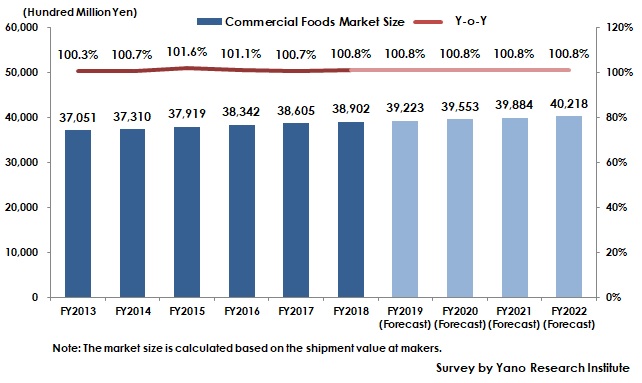No.2189
Commercial Foods Market in Japan: Key Research Findings 2019
Commercial Foods Market for FY2018 Rose to 100.8% on Y-o-Y to Achieve 3,890,200 Million Yen
Yano Research Institute (the President, Takashi Mizukoshi) has conducted a survey on the domestic commercial foods market, and has found out the market trends, the trends of market players, and the future outlook.

Market Overview
The domestic commercial foods market in FY2018 rose by 0.8% from the previous fiscal year to attain 3,890,200 million yen, based on the shipment value at manufacturers. Stable demands in the markets of food services and ready-to-eat foods have led the entire market to exceed the previous-year results slightly.
The domestic food service market once suffered from slumping consumption, but has currently been on the recovery. The ready-to-eat food market has stably risen, because of more demand from increased dual-income households led by women’s vital participation in society, and from increased elderly households. Particularly, convenience stores have expanded the opportunities for consumers to buy ready-to-eat food or meals as they increased the stores in number, started offering more variety of snack foods (fried chickens, etc.) adjacent to checkout counters, and created eat-in areas which also occurred at supermarkets. This brought about convenience stores and supermarkets to record favorable sales of ready-to-eat meals and foods such as bento, onigiri (rice balls), sandwiches, and fried snack foods.
In addition, the meal service market has been stably growing, too, as more schools started entrusting private food service providers with providing school lunches, and as the demand for meal services at private residential homes and other facilities for the elderly expanded. Furthermore, against the backdrop of labor shortage, the demand for fully cooked meals has been expanding at the user companies of commercial foods to save labor for cooking. All such elements led the entire commercial food market to be on the rise.
Noteworthy Topics
More Than 40% of Enterprises Still Use Telephone and Fax When Ordering Foods for Their Business
In May 2019, corporate questionnaire regarding the trend of commercial food demand and the ordering systems was conducted to 30 users of commercial foods, i.e., food service businesses, ready-to-eat food businesses, meal service providers, and accommodation businesses (hotels).
When asked to the above companies about food ordering system for business administration and for saving labor (multiple responses allowed), 96.7% responded that they have introduced and have been using an ordering system, while 43.3% responded that they also used telephone or FAX for ordering commercial food, and 3.3% used the wholesalers’ websites for ordering.
While almost all the above companies introduced ordering systems, more than 40% of them are still using telephone or FAX for ordering food.
Future Outlook
The domestic commercial foods market is projected to expand to 4,021,800 million yen by Y2022, based on the shipment value at manufacturers.
As the number of foreign tourists in Japan has increased, the demand for dining at accommodation facilities including hotels has been rising, and as the number of dual income households and elderly households has increased, the demand for ready-to-eat meals and foods is projected to stay growing. Therefore, the demand for highly processed food, i.e. fully cooked food, is expected to continue being high at user companies of commercial foods, bringing about the commercial foods market to rise more for the future.
Research Outline
2.Research Object: Food makers, commercial foods wholesalers, food service providers, hotels, and etc.
3.Research Methogology: Face-to-face interviews by the specialized researchers, surveys via telephone & email, and questionnaire
Commercial Foods
Commercial foods in this research mean commercially dealt foods and processed foods supplied to food service providers, ready-to-eat food companies, meal service providers and other processed food enterprises. Commercial foods indicate those processed food used as ingredients to add flavors or to be seasoned, and ready-to-eat products that can be provided as meals (cooked frozen or retort foods including finished or half-finished products) all of which served at restaurants, coffee shops, diners, or Japanese-style bars. Processed foods include those used as ingredients for delis and bento (ready-to-eat meals). Note that those processed foods directly for consumers or sold at general retailers are not included.
Published Report
Contact Us
The copyright and all other rights pertaining to this report belong to Yano Research Institute.
Please contact our PR team when quoting the report contents for the purpose other than media coverage.
Depending on the purpose of using our report, we may ask you to present your sentences for confirmation beforehand.